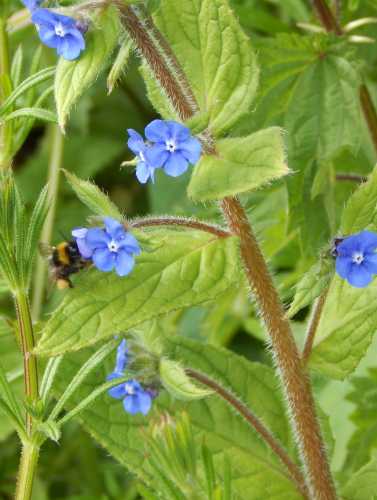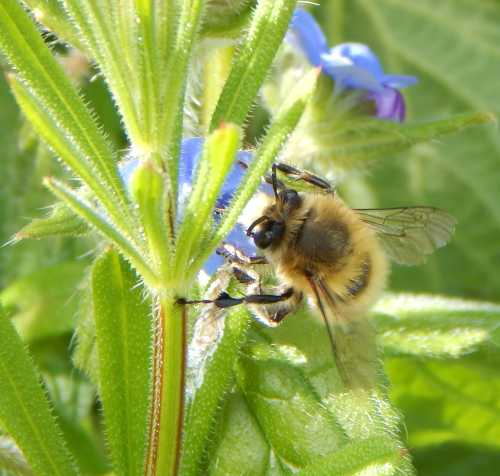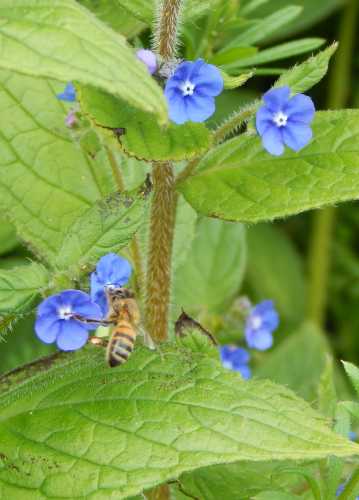Bees Love Green Alkanet!
Along the country lanes where I live, Green Alkanet (Pentaglottis sempervirens) grows in abundance.
It reminds me a little of forget-me-nots, with its small blue flowers, but look closely and the leaves and stem are a give-away that it’s something different.
Anyway, the reason I’m such a big fan of it, is because so many bees of different types absolutely love it: bumble bees, the honey bee, and various solitary species, can all be spotted feeding on this wild flower in late April/May. Thus it provides welcome food in early-mid Spring. It is related to two herb plants also loved by bees: borage and comfrey.
Bees visiting green alkanet
Green Alkanet is a perennial wildflower, native to Western Europe. It is tolerant of slightly shaded verges, but I also see it blooming happily along the sunny roadside verge.
 Bumble bee worker on green alkanet
Bumble bee worker on green alkanetApparently, the word "alkanet" derives from Middle English, and from Old Spanish alcaneta; the genus name Pentaglottis is Greek, meaning "five tongues" and the species name sempervirens is Latin, and means "always alive", or "evergreen".
 Pentaglottis sempervirens - enjoyed by this male hairy footed flower bee (anthophora plumipes)
Pentaglottis sempervirens - enjoyed by this male hairy footed flower bee (anthophora plumipes)Green alkanet blooms in spring and early summer. It can grow upto about 80cm / 32 inches, and the flower stems are quite hairy. Its stamens are hidden inside narrow flower-tubes which end in a white eye in the centre of a blue flower.
According to the RHS, Green alkanet spreads by seed and regenerates from the deep perennial tap root.
 Honey bee foraging on Pentaglottis sempervirens.
Honey bee foraging on Pentaglottis sempervirens.It should be said that some people do regard this plant as 'not ideal' for the garden, for the simple reason that it can spread rapidly. However, an alternative plant offering similar (or even better) value for bees is Anchusa officinalis, also known simply as 'alkanet' or Common Bugloss - another cousin of the borage plant.
More articles about bees and wildflowers
- Bees Love Dandelions - a useful wildflower, especially in early spring Dandelions are beneficial for a wide range of pollinators, including bees, butterflies, and hover flies.
- Bees And Pollinators Visit Rosebay Willowherb Wildflowers for Bees And Pollinators: Rosebay willowherb provides nectar and pollen for bumble bees and honey bees in late summer.
- Wildflowers for Bees And Pollinators: Thistles Bees love thistles, so if you want to photograph bees and pollinators, find a patch of thistles growing on a grassy verge or brownfield site on a sunny day.
- White Bryony Is Attractive To Bees The small whitish-green flowers of the wild vine, white bryony are attractive to bees, including honey bees, bumble bees and various solitary species.
- Wildflowers For Bees And Pollinators: Hemp Agrimony If I were asked to list my top wildflowers for bees and pollinators, hemp agrimony would be on my list. This pretty plant can also be grown in the garden.
- Cash Strapped Councils Could Save Money And Help Bees By Planting Clover Cash strapped councils could save money and help bees and pollinators by planting clover.
- Knapweed Feeds Bees - Centaurea nigra Knapweed Feeds Bees: many bee species (and other pollinators) feed on this important wildflower seen in wildflower verges, grasslands and brownfield sites.
- Bird’s Foot Trefoil: Wildflower Beneficial For Bees Bird’s Foot Trefoil a wildflower beneficial for bees: a rich source of nectar and pollen for bees